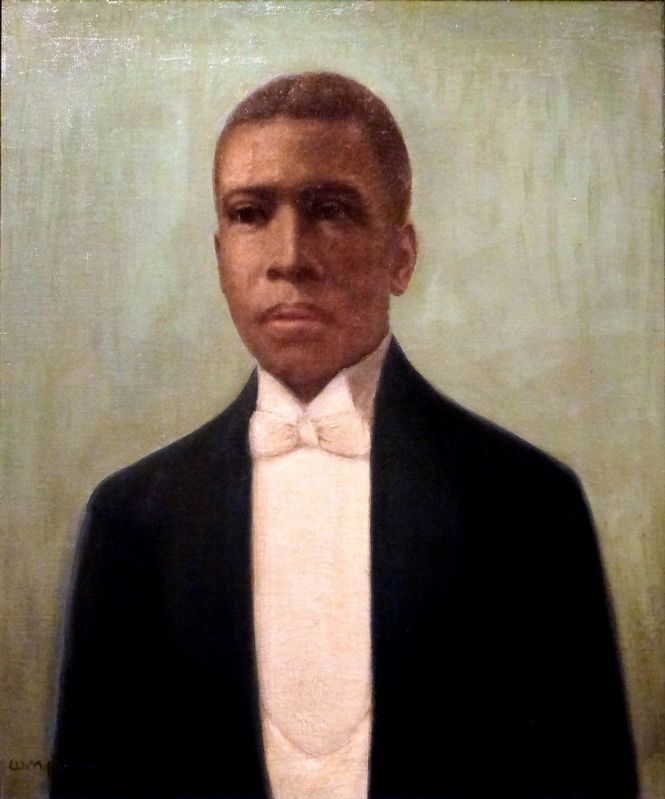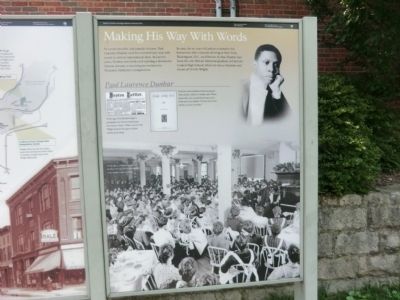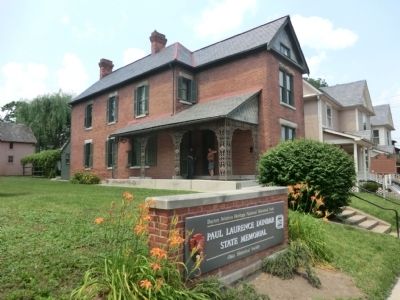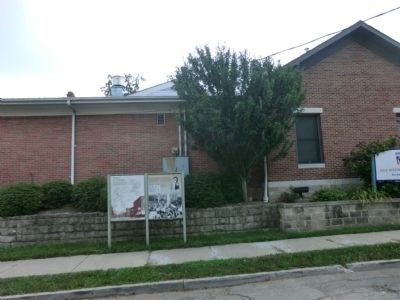Wolf Creek in Dayton in Montgomery County, Ohio — The American Midwest (Great Lakes)
Making His Way With Words
Paul Laurence Dunbar
— Dayton Aviation Heritage National Historic Park —
In 1903, the 30-year-old author returned to his hometown after a decade of living in New York, Washington, D.C., and Denver. In 1891 Dunbar had been the sole African American graduate at Dayton’s Central High School, where he was a classmate and friend of Orville Wright.
At the age of 18, Dunbar began a newspaper for African Americans, the Dayton Tattler. Wilbur and Orville printed the paper at their nearby print shop.
(Inscription over the photo at the bottom left of the marker)
In the 1890s, Dunbar was one of the first African American writers to be widely read by whites.
Dunbar’s first published book of poems, Oak and Ivy, sold for a dollar each. When asked why such a small book had such a hefty price, he replied, “A book sells on ist merits, sir, no on its size.”
Erected by National Park Service, U.S. Department of the Interior.
Topics and series. This historical marker is listed in these topic lists: African Americans • Arts, Letters, Music. In addition, it is included in the Former U.S. Presidents: #25 William McKinley series list. A significant historical year for this entry is 1903.
Location. 39° 45.467′ N, 84° 13.15′ W. Marker is in Dayton, Ohio, in Montgomery County. It is in Wolf Creek. Marker is on Edison Street west of North Paul Laurence Dunbar Street, on the left when traveling west. Touch for map. Marker is in this post office area: Dayton OH 45402, United States of America. Touch for directions.
Other nearby markers. At least 8 other markers are within walking distance of this marker. Rising to the Challenge (here, next to this marker); Paul Laurence Dunbar (within shouting distance of this marker); Coming Home (within shouting distance of this marker); Mount Enon Missionary Baptist Church / Euclid Avenue United Brethren Church (approx. ¼ mile away); The Professor of the Propeller (approx. ¼ mile away); Orville's Last Workshop (approx. 0.3 miles away); 31 Years at the Lab (approx. 0.3 miles away); Major General Harry G. Armstrong (approx. 0.3 miles away). Touch for a list and map of all markers in Dayton.

Photographed By Allen C. Browne, November 29, 2015
4. Paul Laurence Dunbar
This 1934 portrait of Paul Laurence Dunbar (1872-1906) by William McKnight Farrow hangs in the National Portrait Gallery in Washington, DC.
“Regarded by Frederick Douglass as ‘one of the sweetest songsters his race has produced,’ poet Paul Laurence Dunbar became the first African American author to be able to support himself solely through his writings. Although he wrote three novels and many short stories, it was his poetry, written in both standard English and African American dialect, that first caught the attention of a national audience and allowed him to leave his job as an elevator operator. Although many readers gravitated toward his dialect poems that presented a sunny vision of African American life, Dunbar also probed with great eloquence the harsh world of racial segregation and discrimination. His example inspired not only the next generation of African American writers, but also William McKnight Farrow, who like Dunbar grew up in Dayton before moving to Chicago to pursue a career as an artist.” — National Portrait Gallery
“Regarded by Frederick Douglass as ‘one of the sweetest songsters his race has produced,’ poet Paul Laurence Dunbar became the first African American author to be able to support himself solely through his writings. Although he wrote three novels and many short stories, it was his poetry, written in both standard English and African American dialect, that first caught the attention of a national audience and allowed him to leave his job as an elevator operator. Although many readers gravitated toward his dialect poems that presented a sunny vision of African American life, Dunbar also probed with great eloquence the harsh world of racial segregation and discrimination. His example inspired not only the next generation of African American writers, but also William McKnight Farrow, who like Dunbar grew up in Dayton before moving to Chicago to pursue a career as an artist.” — National Portrait Gallery
Credits. This page was last revised on February 4, 2023. It was originally submitted on August 12, 2013, by Don Morfe of Baltimore, Maryland. This page has been viewed 418 times since then and 11 times this year. Photos: 1, 2. submitted on August 12, 2013, by Don Morfe of Baltimore, Maryland. 3. submitted on August 13, 2013, by Don Morfe of Baltimore, Maryland. 4. submitted on November 6, 2017, by Allen C. Browne of Silver Spring, Maryland. • Al Wolf was the editor who published this page.


